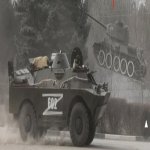I was poking fun at Russian propaganda. They probably suffered 90% casualties and just lied about it. Putin seems to repeating the tried and true tactic of the motherland … attrition at the expense of Human Resources.
Fair enough.
"The first casualty of war, is the truth."
I've been taking pretty much all the info coming out of Ukraine with heaping doses of salt, whether it comes from The Russians or Ukrainians. Both sides have a vested interest in fudging the numbers. Rumor is, that the Captain of the Moskva followed the ancient tradition, or possibly died in the initial explosions. Possibly as many as 450 crew are "missing."
It's a helluva blow to their Navy, not just in terms of the material loss. Flagships are invariably prized assignments, and attract the best and most ambitious officers, Jr. officers, and crews. That's a more difficult hole to fill than the metal and guns of the ship itself.


























































































